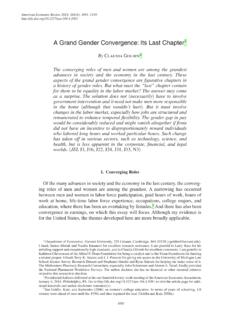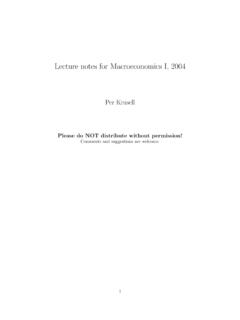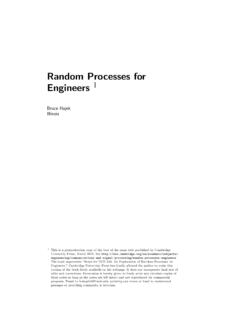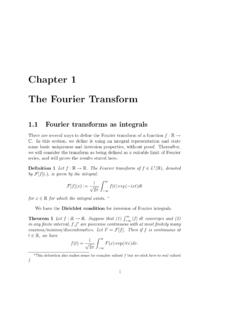Transcription of Chapter 5 Dynamic and Closed-Loop Control
1 Chapter 5 Dynamic and Closed-Loop ControlClarence W. Rowley Princeton University, Princeton, NJBelinda A. Batten Oregon State University, Corvalis, Fundamental principles of feedback .. Models of multi-input, multi-output (MIMO) systems .. Controllability, Observability .. State Space vs. Frequency Domain ..83 Classical Closed-Loop PID feedback .. Transfer functions .. Closed-Loop stability .. Gain and phase margins and robustness .. Sensitivity function and fundamental limitations .. Full-state Feedback: Linear Quadratic Regulator Problem .. Observers for state estimation .. Observer-based feedback .. Robust Controllers: MinMax Control .. Examples .. Galerkin projection .. Proper Orthogonal Decomposition .. Balanced truncation ..27 Associate Professor, Mechanical and Aerospace Engineering, Senior Member AIAA Professor, Mechanical Engineering, Member AIAAC opyrightc 2008 by Rowley and Batten.
2 Published by the American Institute of Aeronautics andAstronautics, Inc., with Multiple equilibria and linearization .. Periodic orbits and Poincar maps .. Simple bifurcations .. Characterizing nonlinear oscillations .. Methods for Control of nonlinear systems ..337 Summary34 Nomenclatureddisturbance input (process noise)eerror between actual state and estimated statefcontrol inputKmatrix of state feedback gainsLmatrix of observer gainsnsensor noiseqstate vector: this may be a vector of velocities(u, v, w),ormay contain other variables such as pressure and density, de-pending on the problemqcstate estimateQweights on the state vector, for LQR cost functionQeprocess noise covariance matrixRweights on the input, for LQR cost functionResensor noise covariance matrixysensed outputzcontrolled output: this vector contains quantities an optimalcontroller strives to keep small vector of parameters basis function Poincar map1 IntroductionIn this Chapter , we present techniques for feedback Control , focusing on those aspectsof Control theory most relevant for flow Control Control has been used for centuries to regulate engineered systems.
3 Inthe 17th century, Cornelius Drebbel invented one of the earliest devices to use feed-back, an incubator that used a damper controlled by a thermometer to maintain aconstant temperature1. Feedback devices became more prevalent during the indus-trial revolution, and James Watt s speed governor for his steam engine has becomeone of the most well-known early examples of feedback recent decades, the use of feedback has proliferated, and in particular, it hasadvanced the aerospace industry in critical ways. The ability of feedback controllersto modify the dynamics of a system, and in particular to stabilize systems that are2naturally unstable, enabled the design of aircraft such as the F-16, whose longi-tudinal dynamics are unstable, dramatically increasing the performance ability of feedback systems to modify a system s natural dynamics is discussedfurther in Sections and recently have Closed-Loop controllers been used in flow Control objective here is to outline the main tools of Control theory relevant to theseapplications, and discuss the principal advantages and disadvantages of feedbackcontrol, relative to the more common open-loop flow Control strategies.
4 We alsoaim to provide a bridge to the controls literature, using notation and examplesthat we hope are more accessible to a reader familiar with fluid mechanics, butpossibly not with a background in controls. It is obviously not possible to give adetailed explanation of all of Control theory in a single Chapter , so we merely touchon highlights, and refer the reader to the literature for further ArchitecturesWithin this section, we describe the basic architecture of a Closed-Loop system, dis-cussing reasons for introducing feedback, as opposed to strategies that do not usesensors, or use sensors in an open-loop fashion. The general architecture of a Closed-Loop Control system is shown in Figure 1, where the key idea is that information fromthe plant is sensed, and used in computing the signal to send to the actuator. Inorder to describe the behavior of these systems, we will require mathematical mod-els of the system to be controlled, called theplant, as shown in Figure 1.
5 We thendesign our controller based on a model of the plant, and assumptions about sensors,actuators, and noise or disturbances entering into the system. We will see that someproperties such as controllability and observability are fixed by the architecture ofthe Closed-Loop system, in particular what we choose as sensors and Fundamental principles of feedbackWhy should one use feedback at all? What are the advantages (and disadvantages)of feedback Control over other Control architectures? In practice, there are manytradeoffs (including weight, added complexity, reliability of sensors, etc), but herewe emphasize two fundamental principles of can modify the natural dynamics of a system. Forinstance, using feedback, one can improve the damping of an underdamped system,or stabilize an unstable operating condition, such as balancing an inverted or feed-forward approaches cannot do this.
6 For flow Control applications,an example is keeping a laminar flow stable beyond its usual transition point. Wewill give specific examples of modifying dynamics through feedback in Section This is true at the linear level if nonlinearities are present, however, then open-loop forcing canstabilize an unstable operating point, as demonstrated by the classic problem of a CPfdyPlantControllerFigure 1: Typical block diagram for Closed-Loop Control . Here,Pdenotes the plant,the system to be controlled, andCdenotes the controller, which we design. Sensorsand actuators are denotedyandf, respectively, andddenotes external sign in front offis conventional, for negative can also reduce sensitivity to external disturbances,or to changing parameters in the system itself (the plant). For instance, an automo-bile with a cruise Control that senses the current speed can maintain the set speedin the presence of disturbances such as hills, headwinds, etc.
7 In this example, feed-back also compensates for changes in the system itself, such as changing weight ofthe vehicle as the number of passengers changes. If instead of using feedback, alookup table were used to select the appropriate throttle setting based only on thedesired speed, such an open-loop system would not be able to compensate either fordisturbances or changes in the vehicle Models of multi-input, multi-output (MIMO) systemsA common way to represent a system is using astate space model, which is a systemof first-order ordinary differential equations (ODEs) or maps. If time is continuous,then a general state-space system is written as q=F(q,f,d),q(0) =q0y=G(q,f,d)(1)whereq(t)is the state,f(t)is the Control ,d(t)is a disturbance, andy(t)is themeasured output. We often assume thatFis alinearfunction ofq,f,andd, forinstance obtained by linearization about an equilibrium solution (for fluids, a steadysolution of Navier-Stokes).
8 It can also be convenient to define acontrol led outputz(t), which we choose so that the objective of the controller is to keepz(t)as smallas possible. For instance,z(t)is often a vector containing weighted versions of thesensed outputyand the inputf, since often the objective is to keep the outputssmall, while using little actuator of the tools for Control design are valid only for linear systems, so the formof equations (1) is often too general to be useful. Instead, we often work with linearapproximations. For instance, if the system depends linearly on the actuatorf,and4if the sensoryand controlled outputzare also linear functions of the stateq, then(1) may be written q=Aq+N(q)+Bf+Dd,q(0) =q0(2)y=C1q+D11f+D12d(3)z=C2q+D21f+D22d. (4)The termAqis the linear part of the functionFabove, andN(q)the nonlinear part(for details of how these are obtained, see Section 6).
9 The termC1qrepresents thepart of the state which is sensed andC2q, the part of the system which is desiredto be controlled. The matricesD,D12,andD21are various disturbance inputoperators to the state, measured output, and controlled output; the disturbanceterms may have known physics associated with them, or may be considered to benoise. Hence, equation (2) provides a model for the dynamics (physics) of the state,and the influence of the Control through the actuators on those dynamics, (3) providesa model of the measured output provided by the sensors, and equation (4), a modelof the part of the system where Control should be the plant is modeled by a system of ordinary differential equations (ODEs),the state will be an element of a vector space, (t) Rnfor fixedt. In the casethat the plant is modeled by a system of partial differential equations (PDEs), ,as with the Navier-Stokes equations, the same notation can be used.
10 In this context,the notationq(t)is taken to meanq(t, ), wheretis a fixed time and the otherindependent variables (such as position) vary. This interpretation of the notationleads toq(t)representing a snapshot" of the state space at fixed time. If denotesthe spatial domain in which the state exists, thenq(t)lies in a state space that is afunction space, such asL2( )(the space of functions that are square integrable, inthe Lebesgue sense, over the domain ). The results in this Chapter will be presentedfor systems modeled by ODEs, although there are analogs for nearly every conceptdefined for systems of PDEs. We do this for two primary reasons. First, the ideaswill be applied in practice to computational models that are ODE approximations tothe fluid systems, and this will give the reader an idea of how to compute , the PDE analogs require an understanding of functional analysis and areoutside the scope of this book.









